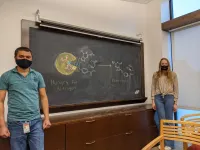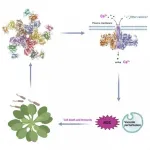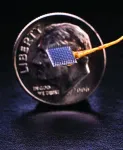Building molecules like Tinkertoys? A breakthrough study may pave the way
UChicago chemists aim to transform the field of chemical discovery
2021-05-12
(Press-News.org) Molecules are the building blocks for our modern world, from phones to cars to Doritos. But coming up with new ones is still an incredibly costly and time-consuming process. A group of University of Chicago chemists wants to find a better way.
"If you look at a diagram of a molecule, it seems like you should be able to just snap them together like Tinkertoys, but you can't," said Asst. Prof. Mark Levin. "We'd like to change that."
Their new discovery, published May 12 in Nature, represents a first step towards that transformation: a way to easily cut nitrogen atoms from molecules.
Despite decades of experiments, chemistry remains an art in many ways because molecules are built in a long, iterative process: attaching some parts, then breaking others so that you can patch new parts in. Every molecule we use, from the fibers in your rug to the dyes that colored it to the detergents you use to clean it, is built this way. But sometimes, the molecules created in the intermediate steps or as byproducts are very toxic, or the whole process takes a lot of time and electricity.
This process becomes even more laborious when scientists or drugmakers are looking for a new chemical, Levin said, since they have to create so many options to test.
"Say you want to make a new drug that targets a part of the cell that biologists have identified as important for heart disease," he said. "Typically, you screen thousands of molecules just to find a few that latch on to that part of the cell. Then you go about modifying them, to make the molecules easier for the body to absorb or to avoid side effects. Every time that you think, say, 'Would it work better with a carbon atom on one side instead of a nitrogen?' you have to go back to the beginning and start over with how to build it."
Levin's group wants to transform the field by introducing ways to directly edit the molecule of interest. There are a few ways to make minor edits around the edges, Levin said, but scientists are still searching for techniques to make major changes to the skeletons of molecules.
The UChicago chemists made a breakthrough in this quest, finding a way to "delete" a nitrogen atom from a molecule. Similar processes currently use generate a very toxic molecule--but Levin's group instead adds a key reagent, or reactive chemical, which bypasses the intermediate step. The nitrogen is released as N2, and two carbon atoms forge a bond in its place.
As a new foundational method, the discovery opens up avenues for constructing molecules.
"One thing it lets you do is think about making rings in a new way, with potentially fewer steps. That lets you change the logic of how you make things," Levin said. (Rings of molecules are a frequent ingredient in chemicals.)
The process doesn't work for every single molecule, but it does for many important ones. For example, Levin's group tested the method on lapatinib, a molecule approved by the FDA as a cancer drug, and was able to edit its composition quickly and easily.
"One side of this discovery is being able to actually work with a class of reactions that was largely underused because they're just awful to work with," Levin said. "But more broadly speaking, we hope it represents a transformation in thinking about how you optimize a molecule."
INFORMATION:
The first author on the paper was Sean Kennedy, a former UChicago postdoctoral researcher now at Johnson Matthey. The other authors on the paper are graduate students Kathleen Berger and postdoctoral researcher Balu Dherange.
Citation: "Skeletal Editing through Direct Nitrogen Deletion of Secondary Amines." Kennedy et al, Nature, May 13, 2021.
Funding: University of Chicago.
[Attachments] See images for this press release:

ELSE PRESS RELEASES FROM THIS DATE:
2021-05-12
In plants, disease resistance proteins serve as major immune receptors that sense pathogens and pests and trigger robust defense responses. Scientists previously found that one such disease resistance protein, ZAR1, is transformed into a highly ordered protein complex called a resistosome upon detection of invading pathogens, providing the first clue as to how plant disease resistance proteins work. Precisely how a resistosome activates plant defenses, however, has been unclear.
A joint team led by Profs. ZHOU Jianmin, CHEN Yuhang and HE Kangmin at the Institute of Genetics and Developmental Biology of the Chinese Academy of Sciences and Prof. CHAI Jijie at Tsinghua University recently employed state-of-the-art electrophysiology and single-molecule imaging to investigate the molecular ...
2021-05-12
Scientists are exploring a number of ways for people with disabilities to communicate with their thoughts. The newest and fastest turns back to a vintage means for expressing oneself: handwriting.
For the first time, researchers have deciphered the brain activity associated with trying to write letters by hand. Working with a participant with paralysis who has sensors implanted in his brain, the team used an algorithm to identify letters as he attempted to write them. Then, the system displayed the text on a screen - in real time.
The innovation could, with further development, let people with paralysis rapidly ...
2021-05-12
PROVIDENCE, R.I. [Brown University] -- Researchers with the BrainGate collaboration have, for the first time, used an implanted sensor to record the brain signals associated with handwriting, and used those signals to create text on a computer in real time.
In a study published in the journal Nature, a clinical trial participant with cervical spinal cord injury used the system to "type" words on a computer at a rate of 90 characters per minute, more than double the previous record for typing with a brain-computer interface. This was done by the participant merely thinking about the hand motions involved in creating written letters.
The research team is hopeful that such a system could one day help to restore ...
2021-05-12
Scientists have for the first time revealed the structure surrounding important receptors in the brain's hippocampus, the seat of memory and learning.
The study, carried out at Oregon Health & Science University, published today in the journal Nature.
The new study focuses on the organization and function of glutamate receptors, a type of neurotransmitter receptor involved in sensing signals between nerve cells in the hippocampus region of the brain. The study reveals the molecular structure of three major complexes of glutamate receptors in the hippocampus.
The findings may be immediately useful in drug development for conditions such as epilepsy, said senior author Eric Gouaux, Ph.D., senior scientist in the OHSU Vollum Institute, ...
2021-05-12
Stanford scientists' software turns 'mental handwriting' into on-screen words, sentences
Call it "mindwriting."
The combination of mental effort and state-of-the-art technology have allowed a man with immobilized limbs to communicate by text at speeds rivaling those achieved by his able-bodied peers texting on a smartphone.
Stanford University investigators have coupled artificial-intelligence software with a device, called a brain-computer interface, implanted in the brain of a man with full-body paralysis. The software was able to decode information from the BCI to quickly convert the man's thoughts about handwriting into text on a computer screen.
The man was able to write ...
2021-05-12
What The Study Did: Researchers describe overdose deaths in San Francisco before and after the initial COVID-19 shelter-in-place order to try to make clear whether characteristics of fatal overdoses changed during this time in an effort to guide future prevention efforts.
Authors: Luke N. Rodda, Ph.D., of the Office of the Chief Medical Examiner for the city and county of San Francisco, is the corresponding author.
To access the embargoed study: Visit our For The Media website at this link https://media.jamanetwork.com/
(doi:10.1001/jamanetworkopen.2021.10452)
Editor's Note: The article includes conflict of interest and funding/support disclosures. Please see the article for additional information, including other authors, ...
2021-05-12
What The Study Did: Rates of preterm birth and stillbirth in Ontario, Canada, during the first six months of the COVID-19 pandemic are evaluated in this study.
Authors: Andrea N. Simpson, M.D., M.Sc., of St Michael's Hospital, Unity Health Toronto, in Toronto, is the corresponding author.
To access the embargoed study: Visit our For The Media website at this link https://media.jamanetwork.com/
(doi:10.1001/jamanetworkopen.2021.10104)
Editor's Note: The article includes funding/support disclosures. Please see the article for additional information, including other authors, author contributions and affiliations, conflict of interest and financial disclosures, and funding and support.
INFORMATION:
Media advisory: The full study is linked to this news release.
Embed this ...
2021-05-12
What The Study Did: This survey study estimated the number of children and adolescents in the United States who have received medical care as a result of assault, abuse or exposure to violence.
Authors: David Finkelhor, Ph.D., of the University of New Hampshire in Durham, is the corresponding author.
To access the embargoed study: Visit our For The Media website at this link https://media.jamanetwork.com/
(doi:10.1001/jamanetworkopen.2021.9250)
Editor's Note: The article includes conflict of interest and funding/support disclosures. Please see the article for additional information, including other authors, author contributions and affiliations, conflict of interest and ...
2021-05-12
What The Study Did: Researchers used registry data to examine the number, characteristics and outcomes of patients with sunburns severe enough to warrant admission to specialist burn services in Australia and New Zealand.
Authors: Lincoln M. Tracy, Ph.D., of Monash University in Melbourne, Australia, is the corresponding author.
To access the embargoed study: Visit our For The Media website at this link https://media.jamanetwork.com/
(doi:10.1001/jamadermatol.2021.1110)
Editor's Note: The article includes funding/support disclosures. Please see the article for additional information, including other authors, ...
2021-05-12
What The Study Did: Delayed localized injection-site reactions to the Moderna COVID-19 vaccine for 16 patients are described in this report.
Authors: Alicia J. Little, M.D., Ph.D., of the Yale University School of Medicine in New Haven, Connecticut, is the corresponding author.
To access the embargoed study: Visit our For The Media website at this link https://media.jamanetwork.com/
(doi:10.1001/jamadermatol.2021.1214)
Editor's Note: The article includes conflicts of interest disclosures. Please see the article for additional information, including other authors, author contributions and affiliations, conflict ...
LAST 30 PRESS RELEASES:
[Press-News.org] Building molecules like Tinkertoys? A breakthrough study may pave the way
UChicago chemists aim to transform the field of chemical discovery


